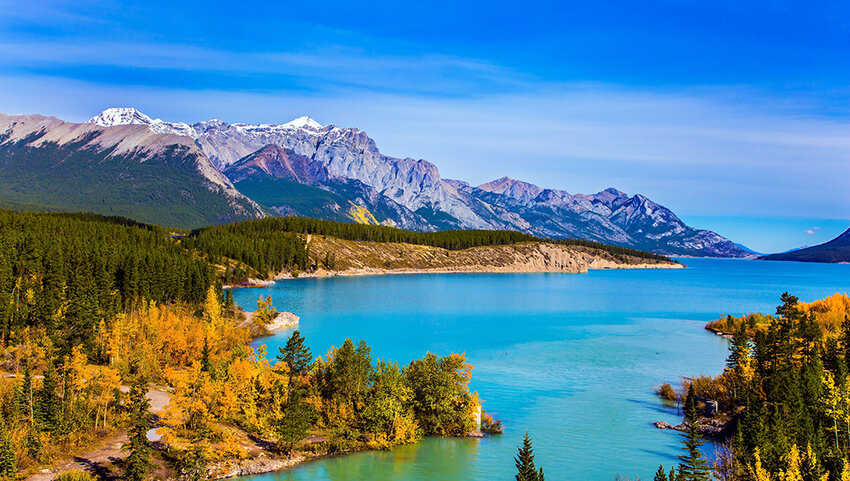There’s nothing like visiting a pretty lake while you’re traveling — but sometimes, everything isn’t quite what it seems. Some of the world’s most breathtaking bodies of water are actually artificial additions to the landscape. Though they’re invaluable as a source of water for agricultural, industrial, or domestic purposes, they often create a plethora of opportunities for leisure, too. Here are some of the world’s most beautiful reservoirs.
Embalse El Peñol-Guatapé - Colombia

There are a slew of reasons why Guatapé is on Colombia’s tourist trail. The houses are decorated with brightly colored bas-reliefs, for one, and a 65-million-year-old lump of granite known as the Piedra del Peñol promises extraordinary views to those who make it up the roughly 600 steps to the top. Without a doubt, however, one of the highlights of that panorama is the Embalse El Peñol-Guatapé, a huge reservoir created in the 1970s as a result of a hydroelectric power station. On a sunny day, you’ll see jet skis, speed boats, canoes, and kayaks out on the lake. It’s also a mecca for water sports enthusiasts, who come here for both the thrill of wakeboarding and water skiing and more relaxing pursuits, such as paddleboarding and fishing.
Zhinvali - Georgia

The ancient Ananuri Fortress complex, a collection of castle and church buildings, is located along the Georgian Military Highway and overlooks a large, gorgeous lake. But this body of water is actually a reservoir created in the 1980s (when the country was part of the Soviet Union) to both address the need for irrigation and to provide water for Tbilisi’s residents. The Zhinvali dam was built across the Aragvi Gorge, submerging the 12th-century Church of the Holy Cross. If you’re there when the water level is low, climb the castle walls and see if you can spot the top of the church peeking above the water.
Wasserfallboden and Mooserboden - Austria

Travel to the Austrian resort of Kaprun between June and October if you’re keen to see the Wasserfallboden and Mooserboden, collectively known as the High Mountain Reservoirs. To reach these artificial Alpine lakes, you need to board the seasonal Lärchwand inclined lift. At the top, hike the educational Electricity Trail or visit Electricity Adventure World, where you’ll find out more about the connections between the glacier, power plant construction, and electricity generation. If you have a head for heights, you can admire the water from above by scaling one of several via ferratas.
Lake Suchitlán - El Salvador

The Cascada Los Tercios waterfall and the viewpoint over Lake Suchitlán, is only a half an hour’s walk from the sleepy town of Suchitoto. Locals call this body of water Cerrón Grande Reservoir, because it came about as a result of the construction of the Cerrón Grande Hydroelectric Power Plant on the Lempa River. Though it provides much-needed electricity for El Salvador, it’s also an important wetland habitat, attracting migratory birds and supporting a wide range of aquatic plants such as water lilies. Lake Suchitlán is also a popular fishing spot, as well as an ideal place to stroll, kayak, paddleboard, or rent a boat.
Lake Jocassee - South Carolina, U.S.

One of the first things you’ll notice when you visit Lake Jocassee is how clear its waters are – after all, it’s fed by streams from the Appalachian Mountains. Yet there’s nothing natural about the lake itself. In fact, this sprawling reservoir didn’t exist before Duke Energy flooded the Jocassee Valley in the early 1970s to build a hydroelectric power station. As the water level rose, local landmarks, such as the Cemetery of Mount Carmel Baptist Church and the Attakulla Lodge Hotel slipped out of sight. Take in the magnificent view at the Jumping Off Rock lookout. Afterwards, admire some of the area’s waterfalls – such as Laurel Fork Falls – on a boat trip, paddle serenely out onto the lake in a kayak, or go for a refreshing swim.
Abraham Lake - Canada

Alberta’s largest reservoir is as blue as the natural mountain lakes in the area — which is to be expected, since they all take their color from glacial rock activity. Measuring 20 miles from end to end, Abraham Lake formed after the Bighorn Dam was built in 1972, blocking off the North Saskatchewan River. Handily located close to Banff National Park, road trippers will enjoy hugging the lakeshore on the David Thompson Highway, giving them breathtaking views of the lake and surrounding mountains. In winter, the lake is especially beautiful. Frozen bubbles form under the ice in a stack as they rise to the surface, the result of trapped methane released by decaying plants on the lake bed.
Blue Lagoon - Iceland

Technically, this lake on Iceland’s Reykjanes peninsula is formed from wastewater from the nearby Svartsengi geothermal power station. Chock full of silica, algae, and minerals, it’s unsuitable for drinking water — but perfect for bathing! Locals started to bathe here in the 1980s, and it has been improved and extended over the years to form one of the country’s most luxurious spas. In recent years, this breathtaking artificial lake has been named one of the 25 Wonders of the World by National Geographic and has earned itself a place on Time Magazine’s list of the World’s 100 Greatest Places. Surrounded by moss-covered lava rock formations and with a hauntingly beautiful view of the industrial complex shrouded by steam, this place is one of the most photogenic spots in Iceland.





